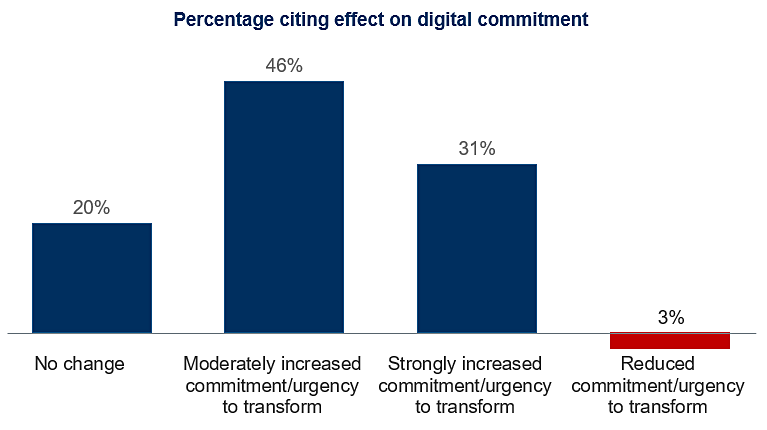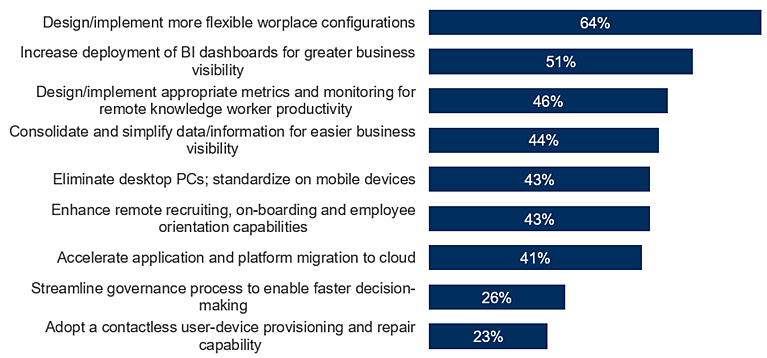In contrast to all the negative operational and financial impacts on businesses from the COVID-19 pandemic, IT organizations have received their greatest level of validation and appreciation since Y2K. Plaudits from the business are not just for IT's crisis and continuity leadership, but for its foresight and wise investments in digital – particularly cloud-based applications and platforms, workforce mobility, and systems making data more easily accessible.
These plus other previous investments in zero-trust cybersecurity and strong provider partnerships mitigated operational disruption so well that half the 250 companies polled by The Hackett Group in late April said they experienced no negative impact to operations from the pandemic shutdown. That’s right, half. As a result, 77 percent of poll respondents say their business leadership now has an increased sense of urgency and commitment to digital transformation. The few who don’t should consider this: Companies whose operations and finances suffered severely from COVID-19 were twice as likely to cite “lack of progress in digital transformation” as a major contributing factor, compared to companies that experienced little negative impact. In other words, digital laggards paid a high price in this crisis.
Extent to which crisis affected business attitudes toward digital transformation

Source: COVID-19 Poll, The Hackett Group, 2020
So, what will IT organizations do with the momentum they've gained? Far from delaying projects, our poll results show that 64 percent of companies intend to continue with transformation as planned. Nearly one in four CIOs say they will accelerate transformation investments that will not only help lead the company out of this period of managed disruption but improve business resiliency.
Businesses’ post-crisis priorities boil down to three categories: increased agility, better insight into the future, and cost takeout. When it comes to agility, three out of four companies will restructure to support a more agile workforce. According to HR leaders, three times as many employees will be working from home permanently compared to before the shutdown, and 67 percent of CHROs say there will be less employee travel and more virtual meetings. IT is being asked to support this with more robust meeting and collaboration tools, which will soon be powered by 5G networks.
|
Related article: Disaster Recovery vs. Crisis Planning: Be ready for both by Bob DeRodes |
With a larger portion of employees working from home, many businesses will want new or updated remote-productivity monitoring and reporting solutions; 46 percent of IT organizations are already working on this. To support a more fluid, ongoing mix of office and remote work, not to mention social distancing, 64 percent of IT organizations are helping enable more-easily reconfigurable office environments, and 27 percent are provisioning more office space specifically for group innovation and creativity.
Most common actions by IT to improve readiness for next disruption

Source: COVID-19 Poll, The Hackett Group, 2020
While the COVID-19 shutdown shined a positive light on the benefits of cloud and mobility, it also exposed the shortcomings in data and information availability. Managers quickly realized they needed better insights to help spot potential disruptions in their supply chains and changes in customer activity. Two out of three procurement organizations insist on better visibility into their second- and third-tier suppliers as part of their new-normal risk management. IT is complying by providing more BI dashboards and by consolidating and simplifying data for easier access.
Predictive analytics for understanding the customer
But it is customer behavior that is primarily driving the need for better statistical modeling and predictive analytics. Businesses need to study customer behavior as lockdowns ease. For consumer industries, the big questions are: How many will return to in-person engagement with businesses? and How quickly?
Among IT leaders, 77 percent expect a permanent increase in customer preference for virtual engagement, and half anticipate customers will want a more customizable virtual engagement. This affords IT an increased opportunity to have a more direct impact on the customer experience. The next breakthrough will be advanced analytics systems that do more than provide numerical insights, which can act autonomously based on those numbers, potentially tailoring the customer’s virtual experience by reading sentiment or judging behavior patterns.
COVID's often catastrophic financial impact on business is a grim context in which to architect the new normal. Sixty-nine percent of companies polled expect moderate to severe financial pressures to continue at least through the summer. One way to mitigate this is through automation: Across all functions responding, 60 percent said they need additional process automation to reduce reliance on manual labor. The Hackett Group’s ongoing benchmark study shows a gap of 28 percent in the number of transactional processes automated between organizations that are world-class in efficiency and effectiveness versus a general peer group. This indicates most companies have many manual processes that are ripe for smart automation technologies such as RPA, augmented with cognitive, intelligent agents/chatbots and AI.
There is another predictable but still regrettable financial impact of the shutdown: The hardest hit companies are shooting themselves in the foot. IT’s 2020 budget has been cut in 51 percent of the companies that suffered a high impact from the shutdown, versus just 11 percent of companies with low impact. Further, more than twice as many of the highly impacted companies are postponing plans to modernize applications and platforms. It is a vicious cycle, as the weakest companies cut funding to IT, the very function that is best positioned to improve enterprise agility, while delaying projects that are essential for resiliency.
As crisis conditions begin to ease in some industries, now is the time for prudent investments in technology aimed at increasing company agility, efficiency and resilience. Some net new funding will be required. But much of the cost will need to be self-funded through IT process efficiencies, complexity reduction and renegotiated contracts. It won’t be easy, but IT organizations now have the advantage of renewed faith and the goodwill of their stakeholders. A year from now, business leaders will look back at 2020 not just for the bleak period of disruption triggered by the pandemic, but as the year of their transformation to a new, and hopefully better, normal.


Written by Richard Pastore
Richard Pastore is Research Principal at SustainableIT.org, a nonprofit organization led by technology executives whose mission is to advance sustainability around the world. Previously, Pastore was Senior Director, Technology Research Advisor for The Hackett Group, a strategic consulting and research firm. He is former editor of CIO magazine, and vice president of the CIO Executive Council.



